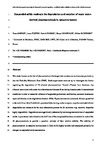Suspended solids moderate the degradation and sorption of waste water-derived pharmaceuticals in estuarine waters.
| dc.contributor.author | Aminot, Y | en |
| dc.contributor.author | Fuster, L | en |
| dc.contributor.author | Pardon, P | en |
| dc.contributor.author | Le Menach, K | en |
| dc.contributor.author | Budzinski, H | en |
| dc.date.accessioned | 2017-11-21T17:47:00Z | |
| dc.date.issued | 2018-01-15 | en |
| dc.identifier.uri | http://hdl.handle.net/10026.1/10246 | |
| dc.description.abstract |
This study focuses on the fate of pharmaceuticals discharged into an estuarine environment, particularly into the Turbidity Maximum Zone (TMZ). Batch experiments were set up to investigate the factors regulating the degradation of 53 selected pharmaceuticals. Treated effluents from Bordeaux city (France) were mixed with water from the estuarine Garonne River during 4weeks under 6 characterized conditions in order to assess the influence of suspended particulates, sterilization, untreated wastewater input and dilution on the degradation kinetics. Of the 53 pharmaceuticals monitored, 43 were quantified at the initial time. Only 7 exhibited a persistent behavior (e.g. carbamazepine, meprobamate) while biotic degradation was shown to be the main attenuation process for 38 molecules (e.g. abacavir, ibuprofen highly degradable). Degradation was significantly enhanced by increasing concentrations of suspended solids. A persistence index based on the half-lives of the compounds has been calculated for each of the 43 pharmaceuticals to provide a practical estimate of their relative stability. The stability of pharmaceuticals in estuarine environments is likely to be highly variable and attenuated primarily by changes in suspended solid concentration. | en |
| dc.format.extent | 39 - 48 | en |
| dc.language.iso | en | en |
| dc.subject | Adsorption | en |
| dc.subject | Degradation | en |
| dc.subject | Estuarine waters | en |
| dc.subject | Persistence | en |
| dc.subject | Pharmaceuticals | en |
| dc.subject | Wastewater | en |
| dc.title | Suspended solids moderate the degradation and sorption of waste water-derived pharmaceuticals in estuarine waters. | en |
| dc.type | Journal Article | |
| plymouth.author-url | https://www.ncbi.nlm.nih.gov/pubmed/28850851 | en |
| plymouth.volume | 612 | en |
| plymouth.publication-status | Published online | en |
| plymouth.journal | Sci Total Environ | en |
| dc.identifier.doi | 10.1016/j.scitotenv.2017.08.162 | en |
| plymouth.organisational-group | /Plymouth | |
| plymouth.organisational-group | /Plymouth/Faculty of Science and Engineering | |
| dcterms.dateAccepted | 2017-08-15 | en |
| dc.rights.embargodate | 2018-09-01 | en |
| dc.identifier.eissn | 1879-1026 | en |
| dc.rights.embargoperiod | Not known | en |
| rioxxterms.versionofrecord | 10.1016/j.scitotenv.2017.08.162 | en |
| rioxxterms.licenseref.uri | http://www.rioxx.net/licenses/all-rights-reserved | en |
| rioxxterms.licenseref.startdate | 2018-01-15 | en |
| rioxxterms.type | Journal Article/Review | en |


